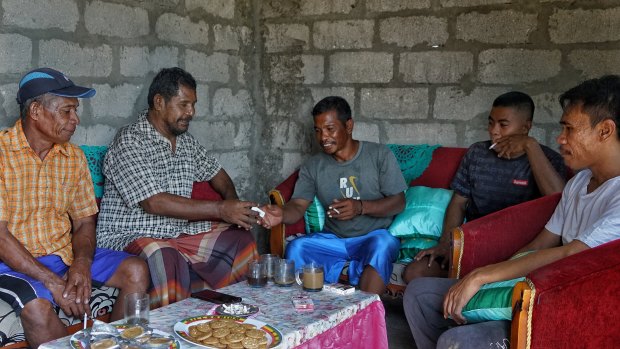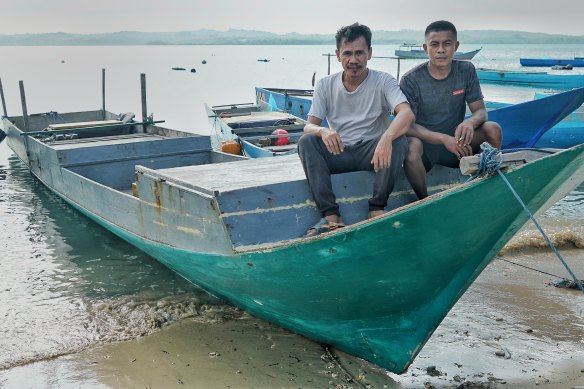This was published 11 months ago
The reality behind the headlines of Indonesia’s people smugglers
By Zach Hope
What in the World, a free weekly newsletter from our foreign correspondents, is sent every Thursday. Below is an excerpt. Sign up to get the whole newsletter delivered to your inbox.
Greetings from Singapore.
It has been a lively few weeks in this neck of the woods. Gregor Haas, father of NRL star Payne, was arrested in the Philippines. Turbulence forced a Singapore Airlines plane into an emergency landing in Bangkok. Last Saturday, we began our series on Indonesian people smugglers and fishermen.

The fishermen gathered in the Papela home of Dahlan Karabi (second from left) to share their troubles with us.Credit: Amilia Rosa
Squeezed in here, too, was the birth of our little girl, Eloise. On this, I will say the Singaporean hospital system is as you might expect – excellent and expensive. Thank you to the doctors and nurses at Mount Elizabeth Novena.
But this is not a daddy blog, so let us go instead to Papela, an impoverished fishing village on the eastern edge of Indonesia’s Rote Island, and inside the home of fisherman-turned-smuggler-turned-fisherman, Dahlan Karabi.
The house is built from cement bricks that don’t all quite fit together (“too many mosquitoes”) and is covered by a corrugated iron roof (“you can see how I live”). We drink sweet, milky coffee served by his gracious wife Aminah, who waits by a curtain that divides our smoking area from peeking grandchildren.
He has invited us around to learn about fishermen’s troubles, and we are soon on the subject of people smuggling. It is a live prospect among these assembled men; everyone needs to pay the bills somehow.
At 60 years of age and with health problems, Karabi, for now, has put smuggling behind him.
It comes with some amusement to my Indonesian colleague, Amilia Rosa, when Karabi confesses to having had a hand in an infamous 2015 event she covered with journalist Jewel Topsfield.
The smuggling mission was carrying 65 asylum seekers to New Zealand when it was intercepted by Australian officials. The story became remarkable, however, when Jewel and Amilia revealed that Australia had paid the smugglers wads of cash to turn the boat around, leading to calls for a royal commission. It was a big and difficult scoop. Karabi chuckles at Amilia’s reaction – small world and all that.
The men gathered at the house deny any involvement in two successful boat runs of illegal immigrants to Australia this year, but they know who we need to speak to. “There are two [groups of] people who know how to actually get to Australia and back undetected,” says Kasim. “If it’s not us, it has to be the other guys.”
The “other guys”, according to these guys, are from a dot in the southern South-East Sulawesi islands, so small not even Amilia has heard of it. In the car back to our hotel in Ba’a we make the call to bin our other plans and try for Maginti Island instead.
The next few days are a blur of flights, airport waiting lounges and hot and sweaty ferries that inch us variously through Kupang, Denpasar, Makassar, Kendari and, eventually, to Muna Island. Getting to Maginti requires paying the brother of the head of a village to fire up a small fishing boat and rustle up a crew.
Waiting for us (locals have been making phone calls) is the hospitable but evasive Ali Imran – one of two chiefs on the island – along with dozens of curious locals. Selfies ensue. I am the first Westerner to visit Maginti for years, possibly decades, Imran explains.
In his living room, he says the market for fresh fish collapsed during the pandemic and fish stocks are on the decline from unsustainable practices. He bats away the Rote islanders’ allegations of people smuggling. While his fishermen have no choice but to go to the Australian coast for a pay day, they don’t take immigrants – at least, not any more.g
As for having exclusive knowledge about how to reach Australia for its valuable sea cucumbers, also called trepang, he says this is rubbish too. “Once we had a successful journey, everyone started imitating,” he says of the trepang runs. “It has now spread to all the regencies around us.
“If there’s ever people smuggling activities to Australia, they keep saying, ‘It’s the Maginti people’. But I am very certain there is no one from Maginti Island who actually smuggled people this year.”
Gratified by the islanders’ warmth but dejected at the apparent dead-end, we head back to Muna Island, where a surprise arrives at our hotel in the form of three Indonesian officials. Since meeting us the previous day, they have decided they don’t like the look of my (valid) journalist visa.
They eventually leave (thankfully without me). The details of what happens next must be omitted to protect certain identities, but unknown to us or these officials at the time is that their bizarre interrogation has set in motion a series of happenings that leads to Bombana regency – next door to Maginti Island – and to people smuggler, Ali Sarwano.
Sarwano (not his real name) was among the trio who successfully evaded Australia’s Border Force in February to drop 39 South Asian asylum seekers near the WA bush community of Beagle Bay.
Imran was mistaken. Sarwano’s two colleagues were, in fact, from Maginti, just like the Rote islanders suspected.
Australian authorities tend to brand all people smugglers as “evil”, lumping the desperate, small fish with the profit-making whales. The 30-something Sarwano (he does not know his exact age) accepted the job for only $3000 to pay off debts at the local shop. He regrets his choice, not least because of the wrath of his wife and mum. He does not strike me as bad. Just a desperate young man.

Trepang men Kasim (left) and Renaldy on a boat used to reach the Australian mainland. Credit: Amilia Rosa
You can read more about him here and here, and watch our joint investigation with 60 Minutes here.
On Rote Island, Karabi had told us the futility of trying to make a living from fishing close to home was driving men to the illicit trades of trepang, shark fin, fish and people.
He has two requests. One is compensation for the 2009 Montara oil spill off the coast of Western Australia that he says irreparably ruined fish stocks.
The other is for our government to allow boats fitted with engines inside the “MOU box”, a large patch of Australian waters agreed between the two countries via a memorandum of understanding where cross-border fishermen can operate legally.
With the aid of power, they could avoid deadly reefs. “By limiting the engines, they are killing us. Literally killing us,” he says.
One of the group at Karabi’s house, Kasim, told us he would add people to his Australian trepang runs for the right money. “We are trying to tell our story,” he says. “We need the governments in Australia and Indonesia to know the problems and the truth.”
I spoke to lawyer Greg Phelps about the Rote islanders’ plight. He represented local seaweed farmers in a successful class action against the oil company, and is a wealth of on-the-ground knowledge. Phelps says he would have loved to have run a case for the fishermen – whom he believes were even more affected than the seaweed farmers – but the team had the best chance of success running a narrow case.
Beyond the issue of environmental damage, he is also troubled by the Australian policy of burning illegal boats.
“You’ve got all these out-of-work fishermen because they’ve lost their boats, and out of work because of Montara,” he says. “It put all these experienced skippers sitting out there under a f---ing palm tree in the village rather than being out there in their own boat. It’s the perfect environment for the real smugglers to come along and prey on them.”
Of course, it is complex. To truly “stop the boats”, however, perhaps the Australian government must consider complementing its ocean deterrence approach with strategies that offer a future and hope to Indonesia’s fishermen.
Get a note directly from our foreign correspondents on what’s making headlines around the world. Sign up for the weekly What in the World newsletter here.